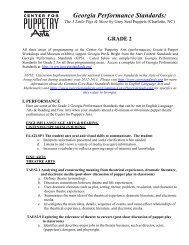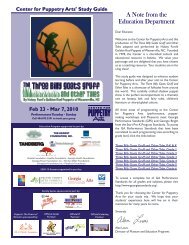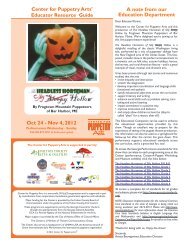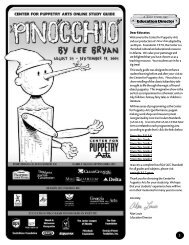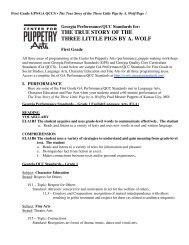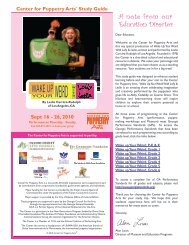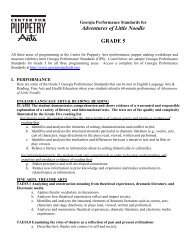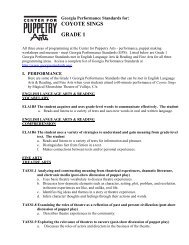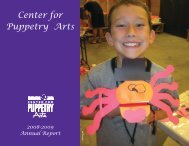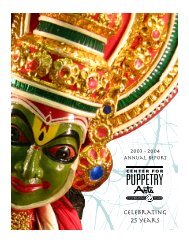Brer Rabbit & Friends - Center for Puppetry Arts
Brer Rabbit & Friends - Center for Puppetry Arts
Brer Rabbit & Friends - Center for Puppetry Arts
You also want an ePaper? Increase the reach of your titles
YUMPU automatically turns print PDFs into web optimized ePapers that Google loves.
Synopsis<br />
Brains beat brawn when <strong>Brer</strong> Bear, <strong>Brer</strong> Fox, <strong>Brer</strong> <strong>Rabbit</strong>, and Sister Mud Turtle find themselves in a briar patch of trouble!<br />
The day gets off to a rousing start with a jam session of live banjo, piano and tambourine when the gang gathers to sing<br />
an early morning ode to the day. As the day passes, our colorful friends act out the stories of “<strong>Brer</strong> <strong>Rabbit</strong>’s Laffin’ Place,”<br />
“How the Bear Got His Tail,” “Sister Mud Turtle Shows Her Strength,” “<strong>Brer</strong> Fox Plays Dead,” “<strong>Brer</strong> <strong>Rabbit</strong> Scares <strong>Brer</strong><br />
Fox and <strong>Brer</strong> Bear” and finally, “The Wonderful Tar Baby.” These delightful stories illustrate classic standoffs between the<br />
weak and the powerful that are a part of every culture’s folklore.<br />
About the Stories<br />
Joel Chandler Harris (1845-1908) was born in Eatonton, Georgia, and<br />
was raised by his single mother. He grew up very poor. When he was 14<br />
he became a printer’s assistant on a plantation so large that it published<br />
its own newspaper. On the plantation, Harris was introduced to African-<br />
Americans who were <strong>for</strong>ced to work as slaves. He befriended two elderly<br />
slaves, George Terrell and “Old Harbert”, who entertained him with<br />
folktales of <strong>Brer</strong> <strong>Rabbit</strong> and <strong>Brer</strong> Fox. Many of these tales were retellings<br />
of West African trickster stories, featuring Anansi the Spider, that had<br />
been passed down <strong>for</strong> generations. Harris had an ear <strong>for</strong> the dialect in<br />
which the men spoke and recorded the stories exactly as they were<br />
spoken at the time. Like the Brothers Grimm, Harris did not invent the<br />
stories he published, but dedicated himself to documenting an important<br />
oral tradition <strong>for</strong> posterity. The result was the single largest collection<br />
of African-American folktales ever published. His first collection of<br />
poems and proverbs was published in 1881 as Uncle Remus: His Songs<br />
and Sayings. (Harris created the fictitious character “Uncle Remus” who<br />
served as the narrator of his books.) A contemporary of Mark Twain,<br />
Harris also worked as a newspaper writer and editor. Harris lived in his<br />
Atlanta home, The Wren’s Nest, from 1881 until his death in 1908.<br />
Style of <strong>Puppetry</strong><br />
<strong>Brer</strong> <strong>Rabbit</strong> & <strong>Friends</strong> is per<strong>for</strong>med by five skilled puppeteers using a variety of puppetry styles. As students will observe,<br />
certain types of puppets work best <strong>for</strong> certain types of characters. One type of puppet used in our show is a hand-and-rod<br />
puppet. <strong>Brer</strong> <strong>Rabbit</strong> and <strong>Brer</strong> Fox are examples of hand-and-rod puppets. A puppeteer operates a hand-and-rod puppet by<br />
placing one hand inside the head of the puppet to turn the puppet’s head and operate its mouth. A puppeteer opens and<br />
closes that hand to make the puppet’s mouth move as she/he provides the character’s voice. This is known as lip-synching.<br />
The puppeteer’s other hand operates the control rods attached to the puppet’s hands (or paws). Our puppeteers per<strong>for</strong>m<br />
their hand-and-rod puppets from behind a low wall known as a playboard. Seated on low rolling carts, the puppeteers<br />
stretch their arms above their heads to per<strong>for</strong>m the puppets in the lighted playing area on top of the playboard.<br />
You will also notice shadow puppets in our production – projections of the 3D puppets, hand shadows and painted<br />
plexiglass. They are per<strong>for</strong>med either on an overhead projector or in an “alley” between a shadow screen and a very bright<br />
halogen bulb. This way, the silhouette image that the puppeteers create on the shadow screen can be much larger than<br />
the actual puppet itself. A shadow puppet of Sister Mud Turtle is used in the scene where she swims to the bottom of<br />
the pond.<br />
In order to bring their characters to life, the puppeteers in our show sometimes appear in special costumes. <strong>Brer</strong> Bear is<br />
an example of a costumed puppeteer. All of the character voices and animal sounds are per<strong>for</strong>med live by the cast. Each<br />
puppeteer wears a cordless microphone to amplify her/his voice.<br />
© 2008 <strong>Center</strong> <strong>for</strong> <strong>Puppetry</strong> <strong>Arts</strong>. All Rights Reserved.<br />
Joel Chandler Harris<br />
2



